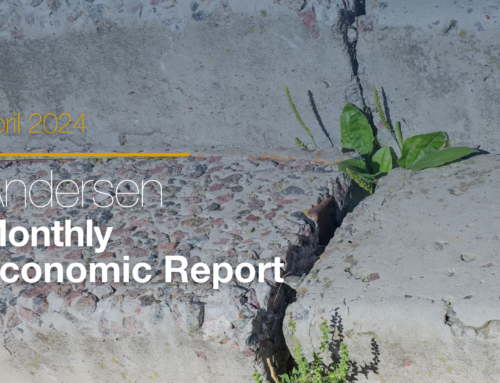Biological Thinking and Organizational Strategy
TEC members may be exposed to a proprietary workshop exploring the concept of “Biological Thinking”, one of the newest resources that TEC offers. This type of business strategy was adapted from research by Martin Reeves of the Boston Consulting Groups’ Henderson Institute (BHI) and focuses on sustaining competitive advantage throughout long-term economic turbulence.
In a nutshell, this is an organizational strategy that examines various principles that allow a biological system to succeed and incorporates those same principles into a structured business plan. In this article, we will be giving a brief overview of the methodology and the competitive advantages this approach might offer in times of economic uncertainty.
Defining Traditional Organizational Strategy
First, to effectively weave this new thinking into a strategic plan, it’s beneficial to establish some foundational language around organizational strategy and traditional systems of thinking. Research from McKinsey states that organizational health is the determining factor for predicting a company’s long-term success.
The three elements that define organizational health are how well the organization aligns with a common vision, how well it executes this vision, and how well it innovates and renews itself to adapt to changing economic climates. Organizational strategy, on the other hand, is the arrangement of a business’s resources regarding its vision and long-term goals. When put together, an intentionally structured organizational strategy maintained over time leads to robust and resilient organizational health.
In times of relative stability and control (i.e., the last few decades), the organizational strategy that Reeves calls “Mechanical Thinking” is the dominant way of approaching a business structure. This emphasizes efficiency and short-term performance. However, as the economy slips into a period of prolonged turbulence, adopting a more biological approach could be the key to bottom-line success.
Introducing Biological Thinking in Organizational Strategy
In his TED Talk, How to Build a Business that Lasts 100 Years, Reeves reveals that companies are failing younger than ever. During the 1970s, the average lifespan of a US public company was approximately 60 years, whereas today it is closer to 30 years. There is also a 32% probability that a new company today will not live to see its 5th anniversary. Now, with inflation on the rise and no landing in sight, a shrinking workforce, and disruptive technologies, business leaders face greater headwinds than ever.
In Reeves’ research, he notes that biological systems have evolved to prioritize resilience and continuity rather than efficiency, which can be an effective model for businesses during high-consequence environments. The principles of Biological Thinking were derived from a study where they were observed as critical factors in successful societies, systems, and businesses throughout history.
For context, let’s look at the biology of the human immune system. Our blood carries multiple varieties of cells that can identify and attack potentially dangerous foreign bodies. If one type of cell is unable to function, another can step in and take its place. This type of diversity can be applied to an organizational structure as well, having multiple suppliers, for example, in case one is unable to fulfill its quota due to unforeseen production or supply-chain disruptions.
The 6 Principles of Biological Thinking
As part of this exclusive TEC workshop provided by Chairs who see the need for it in their groups, TEC Members perform a SWOT analysis of their business to discover where their organizational strategies are succeeding or lacking. They then use Biological Thinking in their business planning and strategic management.
Here is a brief outline of the 6 principles of “Biological Thinking” and where they fit within a business environment.
1. Redundancy
duplication of elements, such as production facilities, technologies, product functions, etc. to provide a buffer against disruptions or changes.
Types of Redundancy:
- Physical Redundancy, or the physical duplication of elements that do the same thing.
- Functional Redundancy, or the designing of elements to serve alternate, duplicate purposes (that are being done by other elements).
2. Diversity
differing elements, such as locations, markets, R&D, and technology to allow for faster reactions to shifting conditions and decrease the risk of a weak link in the system.
Types of Diversity:
- Physical Diversity, or the physical diversification of elements that do different things.
- Functional Diversity, or the designing of elements to serve alternative, distinct purposes (that aren’t being done by other elements).
3. Modularity
the separation of elements or functional units in a broader system that are loosely linked, to create “circuit breakers” in case of the collapse of a part of the system.
4. Embeddedness
the integration of elements, modular units, or the company itself into a larger system to allow interdependencies and support from within the system.
Types of Embeddedness:
- Internal Embeddedness, or the integration of products, offices, and supply/production into the company’s own structure or ecosystem.
- External Embeddedness – the integration of the company as a whole into a larger supply chain, economy, governmental, or societal structure.
5. Prudence
regularly anticipating shifts in the environment and understanding the impacts it will have on the business and its elements.
6. Adaption
Often a culmination of the previous principles, the ability for the business to adjust to exterior or interior forces.

1. Redundancy
duplication of elements, such as production facilities, technologies, product functions, etc. to provide a buffer against disruptions or changes.
Types of Redundancy:
- Physical Redundancy, or the physical duplication of elements that do the same thing.
- Functional Redundancy, or the designing of elements to serve alternate, duplicate purposes (that are being done by other elements).

2. Diversity
differing elements, such as locations, markets, R&D, and technology to allow for faster reactions to shifting conditions and decrease the risk of a weak link in the system.
Types of Diversity:
- Physical Diversity, or the physical diversification of elements that do different things.
- Functional Diversity, or the designing of elements to serve alternative, distinct purposes (that aren’t being done by other elements).

3. Modularity
the separation of elements or functional units in a broader system that are loosely linked, to create “circuit breakers” in case of the collapse of a part of the system.

4. Embeddedness
the integration of elements, modular units, or the company itself into a larger system to allow interdependencies and support from within the system.
Types of Embeddedness:
- Internal Embeddedness, or the integration of products, offices, and supply/production into the company’s own structure or ecosystem.
- External Embeddedness – the integration of the company as a whole into a larger supply chain, economy, governmental, or societal structure.

5. Prudence
regularly anticipating shifts in the environment and understanding the impacts it will have on the business and its elements.

6. Adaption
Often a culmination of the previous principles, the ability for the business to adjust to exterior or interior forces.
Business practices that could apply these principles include infrastructure, inventory, technology, production, products, supply chains, distribution, and many other related elements.
Business practices that could apply these principles include infrastructure, inventory, technology, production, products, supply chains, distribution, and many other related elements.
Conclusion
In an uncertain and ever-changing economic environment, businesses need intentional and specific organizational strategies to remain resilient. With a TEC membership, you’ll have access to expert peers and mentors to help you lead an organization that is adaptable, diverse, and able to withstand the most challenging conditions. Dig deep into novel concepts like Biological Thinking, and many more, to stay ahead of the curve and outlast the competition.
Conclusion
In an uncertain and ever-changing economic environment, businesses need intentional and specific organizational strategies to remain resilient. With a TEC membership, you’ll have access to expert peers and mentors to help you lead an organization that is adaptable, diverse, and able to withstand the most challenging conditions. Dig deep into novel concepts like Biological Thinking, and many more, to stay ahead of the curve and outlast the competition.
To ensure your business’s prosperity in this economic turbulence, locate your personal floatation device (TEC Canada) for support in adopting new organizational strategies. Don’t wait to start building resilience. Join TEC Canada today and discover how our unique peer group model can help your business not just survive but thrive!




